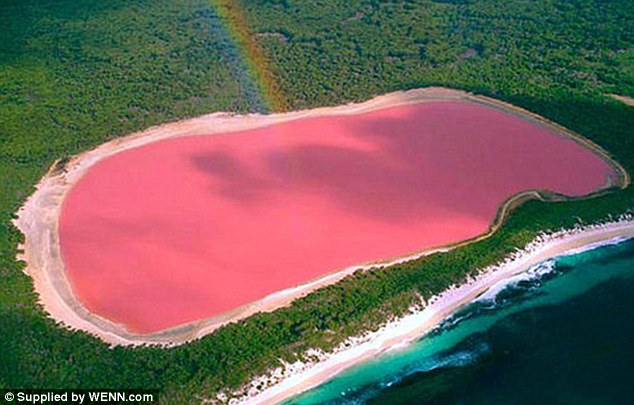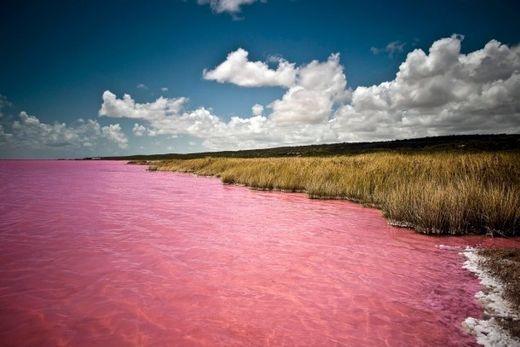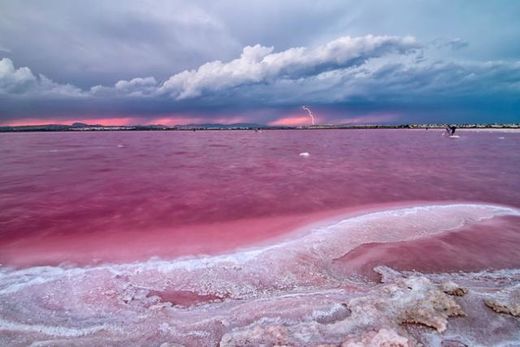
© www.dailymail.co.ukLake Hillier, Recherche Archipelago, Western Australia
Indeed, the natural world presents some of the most unlikely sights the universe has to offer - so unlikely, in fact, that photographs of them could lead the skeptical to believe that the images have been manipulated on a computer. Such is possibly the case with these stunning pink lakes.
The unusually colored bodies of water appear utterly surreal, as if someone has poured a huge vat of pink food coloring into them. However, they're actually
a completely natural phenomenon - something that only adds to the awe experienced upon first viewing them.
One such watery phenomenon certainly surprised 19th-century British explorer Matthew Flinders, who was also a renowned navigator and hydrographer - a scientist concerned with bodies of water. Flinders landed the
Investigator off
Middle Island in Western Australia's Recherche Archipelago in early 1802. After climbing the island's highest peak - now named after him - Flinders looked down to see a "small lake of a rose color;" this was something so incredible that Flinders made note of it in the first volume of his book
A Voyage to Terra Australis. Flinders afterward dubbed the waters
Lake Hillier, in memory of a crew member of the
Investigator who had succumbed to dysentery.
Today, passing airline travelers are afforded especially stunning views of the almost 2,000-foot-long lake, with many folks likely struck by the contrast between the abundantly green trees that surround it and the unmistakably pink water.
Unlike the case with other pink lakes,
the precise reason for Lake Hillier's rosy hue has not been determined. However, it's suggested that - as with many of its pink cousins across the globe - the body of water owes its brilliant coloring to one thing in particular: algae.
More specifically,
an algae known as Dunaliella salina is thought to often provide this unusual coloring. This microorganism is at home in a saline environment, such as that provided by several of the pink lakes.
Dunaliella salina's unmistakable reddish pigment takes in the sun's rays in order to generate energy - and this process, in turn, results in the surrounding water appearing pink.
Another theory for the phenomenon pinpoints archaea called Halobacteria. Much like
Dunaliella salina, these microbes prosper in salty settings and when flourishing lend a rosy color to their liquid environments.
Interestingly, though, neither of these theories hold true at Dusty Rose Lake in British Colombia, Canada, as it is not particularly saline and nor is it full of
Halobacteria or
Dunaliella salina. Instead, the lake gets its strawberry tint from the one-off
configuration of the surrounding rocks.
© photorator.comLake Retba, Senegal
is certainly among West Africa's more unusual attractions. Indeed, until recently it was the last stop on the famous Dakar Rally; Senegal's capital is only some 20 miles southwest of the pink lake. Aside from being a place of interest, though, Retba is also one of industrious hard work: approximately 3,000 workers
excavate salt at the lake before the mineral is shipped far and wide.
These salt "fishermen" rub shea butter on their skin to protect themselves from the potentially harmful effects of prolonged salt water exposure. And the
up to 40 percent salt content of the lake is also a bonus for visiting tourists, as it offers them the rare chance to effortlessly float on water.
With glorious blue sky overhead and piles of white salt along the shore of a sea of pink, the scene at Lake Retba is akin to something from
Alice in Wonderland. Still, far from fantasy, the work the salt miners carry out is difficult.
Many miners spend up to twelve hours, day in, day out, scratching the base of the lake with canes to extract the mineral. After loosening the salt, the workers jump into the water, scooping the fruits of their labor up into their boats. Then, once the "catch" is back on shore, it's examined before being vended for approximately $50 a ton. The salt is also used to keep seafood from spoiling.
Somewhat perversely, it has been said that
mining the lake actually helps to protect it. Because of its high salinity, the water is prone to evaporating faster. By regularly taking salt out, then, the lake is less likely to disappear. Indeed, natives believe that Lake Retba would have long since vanished had mining operations not begun in earnest.
The surreal, almost otherworldly nature of pink lakes might lead to the assumption that they're rare wonders that only the most intrepid explorer is rewarded with seeing. And to a certain extent this is true; the
Masazir Lake in Azerbaijan and Canada's Dusty Rose Lake, for instance, are among the less accessible of these extraordinary bodies of water.

© listas.20minutos.esLas Salinas de Torrevieja in Spain
In strikingly more urban surroundings, though, are
Las Salinas de Torrevieja - Europe's largest salt lakes, which are to be found perched beside the Spanish coastal city of Torrevieja. Interestingly, this pair of pink lakes also result in the area having an unusually healthy microclimate, according to the World Health Organization: a relative abundance of salt combined with balmy temperatures means particularly pleasant weather conditions.
Furthermore, although the salt content in the Spanish lakes is too high for most marine life, the water bodies do nevertheless contain brine shrimp in addition to salt-loving microorganisms. This hasn't impacted on the lakes' moneymaking potential, though; salt extraction has been taking place at Las Salinas de Torrevieja since the 1300s and continues today.
What's more, there is plenty of wildlife to be enjoyed around the Las Salinas de Torrevieja area. In fact, as many as 2,000 flamingos have been spotted in the surrounding nature reserve, and countless other bird and animal species are present, too.
As a rule, these strawberry-colored wonders are relatively rare, with
only a few of them known worldwide. And those lucky enough to come across them should remember that, as delicious as they may look, they're saltier than the sea.
"Somewhat perversely, it has been said that mining the lake actually helps to protect it. Because of its high salinity, the water is prone to evaporating faster. By regularly taking salt out, then, the lake is less likely to disappear. Indeed, natives believe that Lake Retba would have long since vanished had mining operations not begun in earnest. "
An interesting concept, although that one would require some convincing. Wishful thinking or a rare example of modern human symbiosis with the Earth? But we've left out the issue of whether the mining operation pollutes or not...